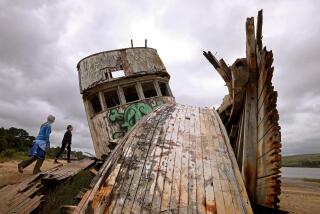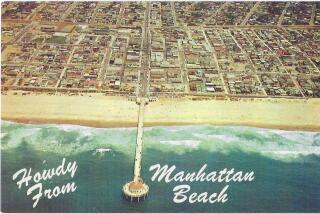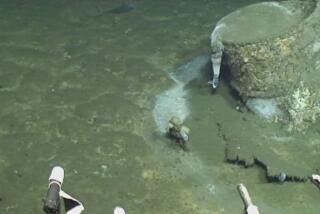Richness of Life Allays Fears as Scientists Study 1987 Wreck
The ship’s bow struck the sea floor so hard it buckled like an accordion. The stern sticks up at an odd 45-degree angle. The belly of the twisted wreckage lies in broken parts, 1,480 feet down, half buried under silt in the black stillness of the deep sea.
Federal scientists just wrapped up their first visit to the Pac Baroness in 14 years, scrutinizing the remains of the 562-foot freighter that collided with another ship in 1987 north of Santa Barbara and sank with its cargo of toxic copper ore.
Environmentalists have worried that the finely powdered copper concentrate might be poisoning sea life. Some fishermen, testifying against proposed marine reserves nearby, blame leaching metals--rather than overfishing--for the Santa Barbara Channel’s steep declines in fish, shellfish and kelp forests.
So a team of scientists set off last week on a Navy research ship for a three-day tour of the site near Point Conception. Using a video camera and relying on the bright lights of an unmanned submarine, the scientists managed to penetrate the darkness and crushing depths. They announced their preliminary findings Monday.
“Our worst fears were not proven to be true,” said Sarah Fangman, research coordinator at the Channel Islands National Marine Sanctuary. “If it were a toxic wasteland, you wouldn’t expect to see the sea life we saw.”
Instead of a dead zone, the scientists saw sablefish, Dover sole, blackgill and thorny-head rockfish swimming amid the wreckage. Sea urchins, sea stars, crabs and sea anemone seem to thrive around and even on the ship. Researchers spotted no evidence of leaking fuel oil.
Still, the initial scouting left the most serious questions unresolved. “Is the wreck a source of major contaminants and trouble for the ocean?” Fangman asked. “I cannot answer that. But some fish and shellfish find it a perfectly acceptable place to live.”
Earlier research, however, pointed to serious contamination, and so federal scientists plan to continue collecting samples of sea water, sediment and sea life to see if there still are pollution problems.
In the months immediately after the shipwreck, Stanley V. Margolis, a UC Davis geology professor, found that some of the 23,000 tons of copper ore and 278,943 gallons of fuel and lubricating oil had found their way into surrounding sediment.
Of greater concern, the toxic copper had entered the food chain, he said. Sea urchins dwelling within 800 feet of the sunken freighter had concentrations of the mineral 100 times higher than those living five miles away.
Last week’s expedition replicated some of Margolis’ survey, scooping up sediment samples in eight areas around the wreck and three separate areas about five miles away. It will take three to six months to analyze these samples and compare them with those of the first expeditions, scientists said.
They hope the sediment will show whether the ore and fuel oil have dissipated, whether they continue to leak slowly from the ship’s holds or whether they have become encapsuled in the sediment that appears to be slowly burying the Pac Baroness. The researchers did not collect urchins or other sea life last week. Nor did they take water samples. That will come later.
The team wanted to make maximum use of the unmanned submarine--a deep sea Maxrover--to take still and video pictures and scoop up sediment samples. The Maxrover and a 200-foot research vessel, the Independence, had been made available by the U.S. Naval Facilities Engineering Service Center at Port Hueneme.
Steering the Maxrover around the Pac Baroness was tricky, said Bob Schwemmer, a shipwreck expert with the Channel Islands National Marine Sanctuary.
Visibility was poor and the slightest movement kicked up clouds of fine-grain sediment that resembled smoke billowing up from the bottom.
“If we didn’t have sonar, we would have been flying blind into these cables,” Schwemmer said. “There was a pretty good current. At one point, it dragged the Maxrover into a cable and it took us awhile to backtrack. That was a very tense moment.”
Besides circumnavigating the wreck, the Maxrover scouted the sea floor about 10 miles away toward San Miguel Island. The idea was to compare sea life at roughly the same depth a significant distance away.
Scientists spotted a slightly higher concentration of sea stars, also called starfish, 10 miles from the wreck. But they found few other differences.
The expedition was funded by the National Marine Sanctuary program, which has 13 sanctuaries, including one that encircles Channel Islands National Park.
The Pac Baroness came to rest about 12 miles southwest of Point Conception, outside the boundaries of the Channel Islands sanctuary. Federal researchers want to make sure the toxic copper ore is not being transported by currents into the sanctuary, or harming the sanctuary’s marine life.
The Pac Baroness, registered in Liberia, was carrying copper ore to Japan when it collided with the 600-foot Atlantic Wing in dense fog on Sept. 21, 1987.
The Atlantic Wing, carrying 3,451 Honda cars, continued its trip to the Port of Long Beach. The crippled Pac Baroness unleased a slick of fuel oil that stretched for 10 miles and sank 11 hours after the collision, disgorging enough fuel oil to create a crescent-shaped slick 10 miles long.
Scientists have no idea how much fuel or copper ore remains in the ship’s holds.






